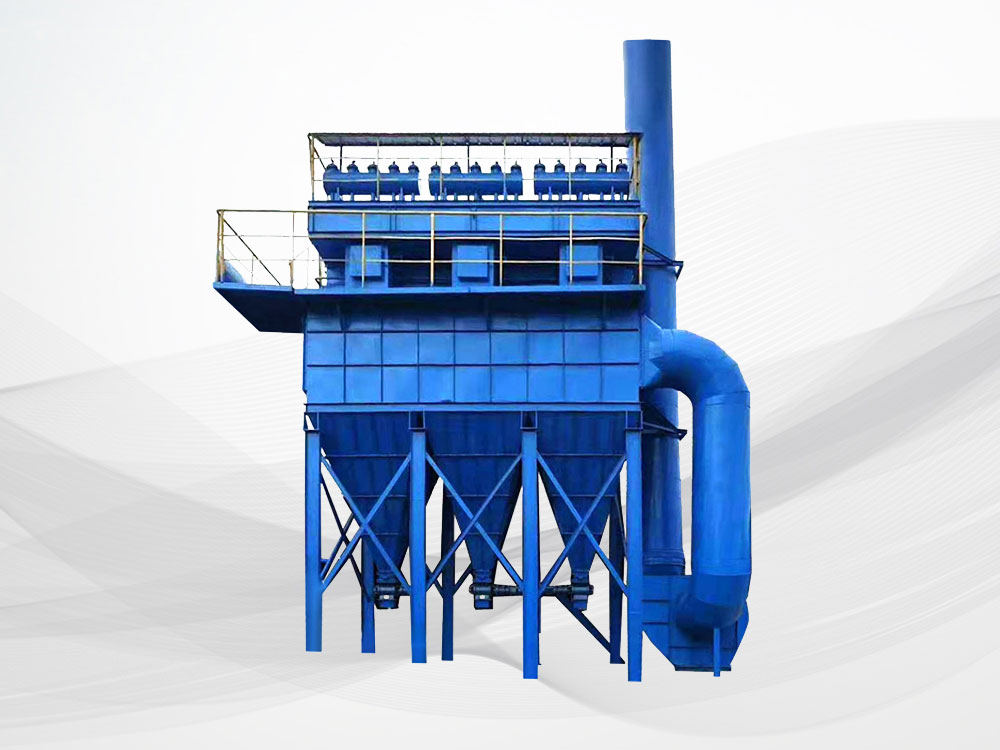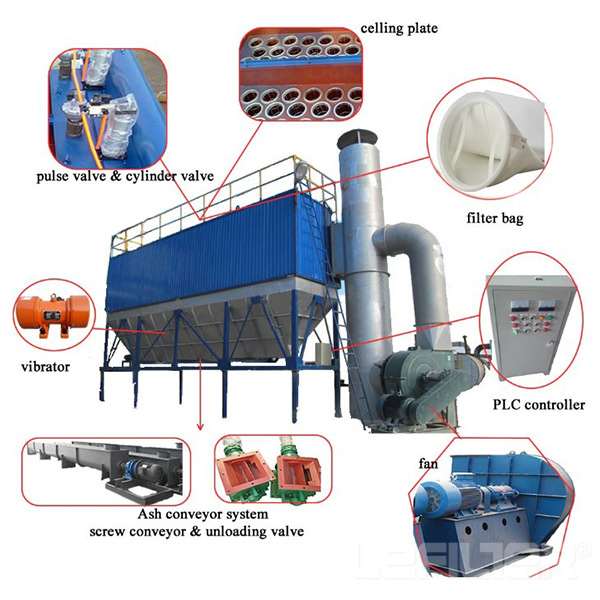Introduction
Industrial activities generate significant volumes of air pollutants, impacting the environment and compromising indoor air quality. The Pulse Jet Bag Dust Collector, a sophisticated air purification device, assists industries in mitigating this problem, thus fulfilling environmental regulatory standards and ensuring a safe and healthy work atmosphere.

Design and Working Principle
The Pulse Jet Bag Dust Collector is specifically designed for filtering and removing air impurities, which contributes substantially to maintaining a clean work environment. The advanced technology incorporated in this device utilizes needle felt bags and high-velocity reverse pulse air jets for dust filtration and de-clogging the filters respectively.
This device operates by introducing dust-laden air into the dust collector's lower chamber, where the larger and heavier particles, guided by a baffle plate, fall into the hopper. The remaining smaller particles go through the filtration phase, where the filter bags effectively become impervious to these tiny pollutants, efficiently trapping them on their exterior surfaces. Clean air then rises and is purged from the top of the filter bags.
The invention’s unique cleaning system is activated when the dust deposition reaches a certain level, creating pressure inside the unit. High-pressure air from the reservior is released, traveling through drilled holes in the blowpipes into the filter bags. This powerful burst of air causes a rapid, momentary swelling of the bags that allows the dust particles to free themselves, fall into the hopper, and thereby ensuring continuous filtration.
Structural Components
The primary body of this dust collector is bifurcated into two portions by a tube sheet. The lower section comprises the inlet, attached to flexible suction pipes that intake polluted air from the surroundings. It also contains the hopper with a rotary air lock system for continuous discharge of dust particles.
The upper body hosts the main filtration system, which incorporates rows of filter bags fastened to the tube sheet. The cleaning system, set above the tube sheet, comprises rows of blowpipes connected to a pressurized air reservior that houses an attached solenoid valve. The upper assembly also includes an outlet attached to pipes for expelling filtered air form the unit.
Pulse Jet Bag Dust Collector Advantages
This dust collector displays several significant advantages over other dust collection systems. One standout feature lies in the bag mouth’s use of an elastic expansion ring that adheres to excellent sealing standards, ensuring both firmness and reliability. The design reflects user-friendliness and convenience with an airtight design, securing an excellent sealing performance and a low air leakage rate.
Synonymous with stability, the Pulse Jet Bag Dust Collector’s architecture allows the maintenance and changing of filter bags in different chambers, all under the normal operation of the system. This feature ensures the system's fan can remain running, hence avoiding any unwarranted downtime. Additionally, the bag keel adopts a polygonal shape to reduce friction and prolong the filter bag's lifespan.
Applications
The Pulse Jet Bag Dust Collector serves a diverse range of industries: cement, woodworking, chemical, foundry, furnace work, grain routing, asphalt manufacturing, rubber, glass, plastic, mineral production, ceramics, stone crushing, battery production, pigment processing, and abrasive blasting. In essence, any operation that generates dust and needs a highly effective, user-friendly, and reliable dust collection system can utilize this innovative device.
Conclusion
The Pulse Jet Bag Dust Collector incorporates efficient design, powerful cleaning ability, and versatile application range, making it an invaluable asset for any dust-generating industry. It goes above and beyond conventional dust collectors, meeting environmental regulations, protecting employees' health, and promoting overall operational efficiency. Businesses seeking reliable, comprehensive, and intelligent solutions to manage air pollutants should consider investing in this technological marvel.
The Pulse Jet Bag Dust Collector carries several significant advantages that make it an optimal choice for many industries. Its key benefits include:
Powerful Cleaning Ability: Through the use of reverse pulse compressed air technology, this dust collector demonstrates superior cleaning proficiency, efficiently removing dust particles accumulated on the filter bags.
High Dust Removal Efficiency: The collector's design channels the dusty air to exhaust most particles before even reaching the filter bags, which greatly enhances its dust removal efficacy.
Good Sealing Performance: The use of an elastic expansion ring at the bag mouth ensures a tight seal, leading to reliable and stable operation.
Operational Safety and Stability: The collector is designed so that the bags can be replaced or maintained without stopping the system fan or the ongoing process.
Adaptability: The collector can be customized according to different dust concentrations and filter materials, meeting a wide range of industry requirements.
The cleaning process of the Pulse Jet Bag Dust Collector is automated and starts when a certain level of dust accumulation is detected. The dust collector uses an air reservoir that stores compressed air. When the bag's pressure drop increases due to dust accumulation, the stored high-pressure air gets released, making its way through the blowpipes and subsequently to the filter bags.
This high-speed air travel causes an instantaneous expansion or "pulsing" effect on the bags, alleviating their exterior surface of the clinging dust particles. The dust particles then fall into the hopper, and the clean bags are ready to continue their filtration duties effectively.
The adaptability of the Pulse Jet Bag Dust Collector makes it suitable for a wide array of industries. These include:
Cement: Used in the extraction of dust particles generated during various cement production stages, like crushing, grinding, etc.
Woodworking: Collects wood dust and chips produced in sawing, sanding, and other woodworking processes.
Chemical: Removes harmful dust particles during chemical preparation and handling.
Foundry: Used during material handling, mold shakeout, and abrasive cleaning, etc., to capture metallic or sand dust.
Furnace: Used for the extraction of fly ash, carbon black, and other furnace-related emissions.
Grain: Removes dust produced in grain handling facilities.
Glass: Used to catch dust particles produced during glass batch mixing and forming operations.
Moreover, industries related to asphalt, rubber, plastic, mineral, ceramics, stone crushing, battery, pigment processing, and abrasive blasting can also utilize the Pulse Jet Bag Dust Collector effectively.
The Pulse Jet Bag Dust Collector is equipped with a pressure gauge that effectively monitors the pressure differential across the filter bags. As dust accumulates on the surface of the bags, the ability of air to flow through them gradually reduces, creating a difference in pressure between the inside and outside of the bag. This difference, or pressure differential, represents the level of dust deposition on the filter bags, which the gauge conveniently senses and reports.
The cleaning process's high efficiency in the Pulse Jet Bag Dust Collector is attributed mainly to its "air-stop" reverse pulse technology. Remember, cleaning is initiated when the pressure differential reaches a predefined level, indicated by the level of dust buildup on the filter bags. The built-in air reservoir releases a short burst of high-pressure air that travels through the blowpipes into the filter bags, momentarily inflating them. This 'pulse' disrupts the layer of dust accumulated on them, making the particles lose their grip and fall into the hopper for collection. This process is quick, happening in a fraction of a second without interrupting the normal air filtration, and since it cleans one row of bags at a time, the filtration process can continue in other areas, ensuring minimal downtime.
The high efficiency and superior filter cleaning ability of a Pulse Jet Bag Dust Collector is beneficial across different industries, especially those involving high levels of dust or particulate matter. These include:
Cement Industries: In mills and crushers where dust is a significant byproduct.
Metal and Foundry Industries: During smelting, casting, and finishing processes where this dust collector can handle high volumes of dust.
Chemical and Pharmaceutical Industries: In chemical synthesis and drug manufacturing stages to remove fine particulates.
Power Generation: Power plants, particularly those burning biomass or coal, where fly ash can be efficiently controlled.
Agriculture: In grain elevators and similar facilities to control grain dust.
Moreover, industries like glass production, rubber, plastic, ceramics, mineral processing, stone crushing, abrasive blasting, woodworking among others dealing with dust or particulate matter, can immensely reap the benefits of a Pulse Jet Bag Dust Collector's high efficiency.
The cleaning process of a Pulse Jet Bag Dust Collector is remarkably efficient and quick, usually taking just fractions of a second to clean a row of filter bags. This process involves releasing a burst of compressed air into the bags — a process coined as 'pulsing' — that effectively dislodges captured dust particles. The high speed and effectiveness of this process is one of the primary advantages of this dust collector, minimizing downtime and facilitating continuous operation.

The pulse jet mechanism in the dust collector is controlled by a programmed pulse control instrument or timer, sometimes coupled with a differential pressure gauge. The high-pressure air is stored in a reservoir within the system. When the pressure gauge detects a certain level of dust accumulation on the bags, and it's time to clean, it triggers the solenoid valve connected to the air reservoir. The consequent release of compressed air travels via the blowpipes and into the bags, creating a sudden expansion, which effectively knocks off the dust particles from the bag surfaces.
The lifespan of a Pulse Jet Bag Dust Collector varies depending on factors like the type and amount of dust it's handling, frequency of use, maintenance standards, and the quality of filter bags being used. However, with proper maintenance and operation, this type of dust collector can typically last for several years. An important note is that the filter bags might need to be replaced periodically depending on their condition and usage, but this preventive maintenance can actually prolong the overall lifespan of the dust collector.







